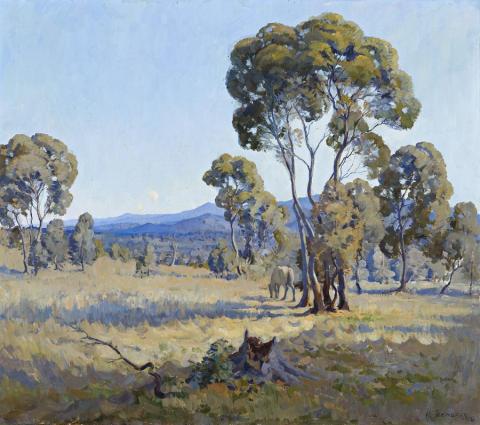SILVER AND BLUE, WOODSIDE, 1924
HORACE TRENERRY
oil on canvas on board
71.0 x 81.0 cm
signed and dated lower right: H. TRENERRY 24
Private collection, South Australia
Spring exhibition, South Australian Society of the Arts Gallery, Adelaide, 12-27 September 1924
The 8th Adelaide Festival of Arts, Adelaide, 9-30 March 1974 (label attached verso)
Klepac, L., Horace Trenerry: 1899-1958, The Beagle Press, Sydney, 2009, p. 132 (illus. p. 45)
Horace Trenerry produced a remarkable body of work, but remained relatively unknown, even in his home state of South Australia. Born in 1899, he was too young for service in World War1 and left school to work in the country, but soon developed an interest in art. He studied drawing and, on returning to Adelaide after the war, he commenced working seriously with Archibald Collins and then in 1919-20, with James Ashton. He moved to the School of Fine Arts under Fred Britton in 1921, followed by a time at Julian Ashton's school in Sydney in 1922. That experience was crucial, leading to his meeting with Elioth Gruner who had a significant influence on his work. Trenerry was drawn back to his home state after only a few months and found considerable success in Adelaide.
Silver and Blue, Woodside, 1924, comes from the year of his first major exhibition at the South Australian Society of the Arts Gallery, Adelaide. The exhibition was a near-sellout and made his reputation as a new artist to watch in Adelaide. There are distinct echoes of Gruner in the painting, but it is an altogether more robust statement than Gruner might have produced. He uses the similar device of a shaded foreground, opening to a sunlit middle ground, with a strategically placed horse picking up a point of focus. The painting has a solidity and confidence that shows the maturity of the twenty-five year old painter. His time in Sydney had opened his eyes to the effects of strong light on the landscape, a technique he was able to bring to the clear unclouded skies of South Australia.
Through the latter 1920s the future seemed assured for the talented young artist, but the onset of the Great Depression in 1929 made sales almost impossible. He had lived and painted at Woodside in the Adelaide Hills from 1922, but was forced to move south to Willunga in 1934, living in poor surroundings, but never giving up the life of an artist. Inspired by Hans Heysen, Trenerry made a visit to the Flinders Ranges in 1930, a journey that changed both his way of seeing the landscape and his mode of painting. The crisp light and clear forms of his earlier works gave way to a softer, more monochromatic palette and an emphasis on atmospheric effects. He looked to English modernism, rather than the French post-impressionism that was beginning to find favour with the younger painters in Sydney and Melbourne. The onset of an inherited disease severely limited his output, after a working life interrupted first by the Depression and then by World War .2 That he produced work of such quality while working alone in rural South Australia is testament to his talent, work ethic and vision.
GAVIN FRY
